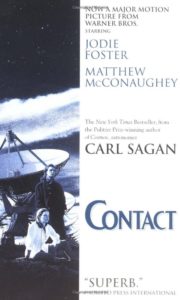 One of the most interesting aspects of this 1985 book about SETI – the Search for Extraterrestrial Intelligence – and first contact with alien life, is the technology. Carl Sagan, noted astronomer, science popularizer, and SETI enthusiast, described a technological Earth in the mid-’80’s, and it’s amazing how antique it seems. There were, of course, no smart phones, hardly any cordless phones at all. There was no internet, no browsers and nothing to browse. Email was still in the future. The personal computer had been invented but was a toy, not a tool of scientific research. Screens of scrolling amber text were the height of sophistication. The reader is supposed to be wowed at a character’s “telefax” that can send a facsimile over a telephone wire at thousands of bits per second.
One of the most interesting aspects of this 1985 book about SETI – the Search for Extraterrestrial Intelligence – and first contact with alien life, is the technology. Carl Sagan, noted astronomer, science popularizer, and SETI enthusiast, described a technological Earth in the mid-’80’s, and it’s amazing how antique it seems. There were, of course, no smart phones, hardly any cordless phones at all. There was no internet, no browsers and nothing to browse. Email was still in the future. The personal computer had been invented but was a toy, not a tool of scientific research. Screens of scrolling amber text were the height of sophistication. The reader is supposed to be wowed at a character’s “telefax” that can send a facsimile over a telephone wire at thousands of bits per second.
The serious theme, though, is contact with an alien civilization. What would it be like? How would we react? What would happen? These are the big questions the novel supposedly addresses.
Supposedly, because much of the novel is absorbed by a shallow diatribe of science versus religion, in which both “sides” are caricatured, resulting in scientism versus fundamentalism. Tired slogans are presented as arguments and no insight is offered. It’s a serious waste of words.
Regardless, an alien message is detected in the SETI lab, is deciphered, and the world goes nuts. Governments try to weaponize, scientists defend the sanctity of curiosity, and the public acts like crazed baboons.
I was especially interested in Sagan’s idea of how one would detect an alien message. What counts as a signal? Any perceived regularity? What counts as a regularity? Are patterns in the mind or in the world?
To my disappointment, this most important question – what counts as a signal – is glossed in the book. A technician in the SETI lab simply says (and this is a genuine quote): “Hey look. It’s a monochromatic signal.” (page 63).
Turns out, the signal was identified by rhythmic pulses in the radio data. A “signal,” it is implied, depends on the human mind’s tendency to form objects, or Gestalts, out of grouped elements, going back to David Hume’s proposal, around 1750, that we spontaneously create patterns when elements resemble each other, occur together, or causally affect each other. Alien psychology would work the same way, in Sagan’s view.
After you believe you have a signal, the next question is, do you have a message? What counts as a message? Stanislaw Lem’s short “novel,” His Master’s Voice, is entirely consumed by these two questions: Is it a signal, and if it is, what is the message? Again, in Sagan’s novel, the question is finessed. The communicative intent of the signal is simply assumed, quickly interpreted (based on some undocumented intergalactic Rosetta Stone), and the message’s instructions are duly followed. (Why? That question is glossed also. Hey, it’s from aliens so it must be good, right?)
The last third of the book is highly implausible, scientifically, and in terms of critical thinking. The protagonist builds a space ship from the signal’s message and travels to a distant galaxy to receive yet another message from the aliens (who take the form of her dead father, for her convenience). Alas, when she returns to Earth, nobody believes her and she is left only with her “faith” that what she experienced was real.
And, I should mention, the closing mini-drama of the novel, and I am not kidding, is that she receives a letter from her dying mother revealing who her real father was. I groaned at that melodramatic cliché, but it fooled the aliens too since, following an old Star Trek episode, they took the image of her (wrong) father from her autobiographical memory.
The novel has not aged well and it doesn’t help that it’s badly written, with narrative exposition and info-dumps substituting for plot and character development. But does it count as an excursion into psi-fi? It does.
The novel addresses some basic questions about human psychology in a technological context, and it tries to adhere to both psychological and technological realism. Unfortunately, the text lacks ideas. It is so concerned with parading its technological prowess that it forgets to offer anything that might illuminate the human condition. It is a missed free-throw.
As ordinary sci-fi, the verdict is about the same. The first part of the novel verges on tedium while displaying technical and mathematical details about radio astronomy and SETI research along with biographical dossiers. It is a relief when the torrential info-dumping tapers off but the replacement, a series of implausible non-sequiturs, is not easy to take either.
Times have changed. Maybe you had to be there in the 1980’s to appreciate what this novel tried to do, even in a primitive way.
Sagan, Carl (1985). Contact. New York: Pocket Books, 431 pp.